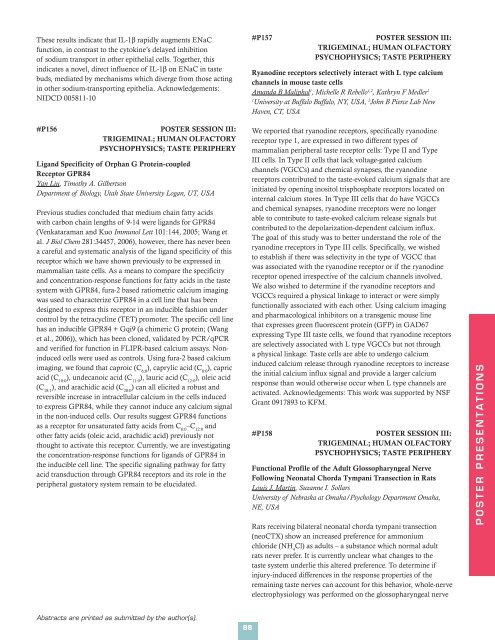Abstracts - Association for Chemoreception Sciences
Abstracts - Association for Chemoreception Sciences
Abstracts - Association for Chemoreception Sciences
Create successful ePaper yourself
Turn your PDF publications into a flip-book with our unique Google optimized e-Paper software.
These results indicate that IL-1b rapidly augments ENaC<br />
function, in contrast to the cytokine’s delayed inhibition<br />
of sodium transport in other epithelial cells. Together, this<br />
indicates a novel, direct influence of IL-1b on ENaC in taste<br />
buds, mediated by mechanisms which diverge from those acting<br />
in other sodium-transporting epithelia. Acknowledgements:<br />
NIDCD 005811-10<br />
#P157 POSTER SESSION III:<br />
TRIGEMINAL; HUMAN OLFACTORY<br />
PSYCHOPHYSICS; TASTE PERIPHERY<br />
Ryanodine receptors selectively interact with L type calcium<br />
channels in mouse taste cells<br />
Amanda B Maliphol 1 , Michelle R Rebello 1,2 , Kathryn F Medler 1<br />
1<br />
University at Buffalo Buffalo, NY, USA, 2 John B Pierce Lab New<br />
Haven, CT, USA<br />
#P156 POSTER SESSION III:<br />
TRIGEMINAL; HUMAN OLFACTORY<br />
PSYCHOPHYSICS; TASTE PERIPHERY<br />
Ligand Specificity of Orphan G Protein-coupled<br />
Receptor GPR84<br />
Yan Liu, Timothy A. Gilbertson<br />
Department of Biology, Utah State University Logan, UT, USA<br />
Previous studies concluded that medium chain fatty acids<br />
with carbon chain lengths of 9-14 were ligands <strong>for</strong> GPR84<br />
(Venkataraman and Kuo Immunol Lett 101:144, 2005; Wang et<br />
al. J Biol Chem 281:34457, 2006), however, there has never been<br />
a careful and systematic analysis of the ligand specificity of this<br />
receptor which we have shown previously to be expressed in<br />
mammalian taste cells. As a means to compare the specificity<br />
and concentration-response functions <strong>for</strong> fatty acids in the taste<br />
system with GPR84, fura-2 based ratiometric calcium imaging<br />
was used to characterize GPR84 in a cell line that has been<br />
designed to express this receptor in an inducible fashion under<br />
control by the tetracycline (TET) promoter. The specific cell line<br />
has an inducible GPR84 + Gqi9 (a chimeric G protein; (Wang<br />
et al., 2006)), which has been cloned, validated by PCR/qPCR<br />
and verified <strong>for</strong> function in FLIPR-based calcium assays. Noninduced<br />
cells were used as controls. Using fura-2 based calcium<br />
imaging, we found that caproic (C 6:0<br />
), caprylic acid (C 8:0<br />
), capric<br />
acid (C 10:0<br />
), undecanoic acid (C 11:0<br />
), lauric acid (C 12:0<br />
), oleic acid<br />
(C 18:1<br />
), and arachidic acid (C 20:0<br />
) can all elicited a robust and<br />
reversible increase in intracellular calcium in the cells induced<br />
to express GPR84, while they cannot induce any calcium signal<br />
in the non-induced cells. Our results suggest GPR84 functions<br />
as a receptor <strong>for</strong> unsaturated fatty acids from C 6:0<br />
–C 12:0<br />
and<br />
other fatty acids (oleic acid, arachidic acid) previously not<br />
thought to activate this receptor. Currently, we are investigating<br />
the concentration-response functions <strong>for</strong> ligands of GPR84 in<br />
the inducible cell line. The specific signaling pathway <strong>for</strong> fatty<br />
acid transduction through GPR84 receptors and its role in the<br />
peripheral gustatory system remain to be elucidated.<br />
We reported that ryanodine receptors, specifically ryanodine<br />
receptor type 1, are expressed in two different types of<br />
mammalian peripheral taste receptor cells: Type II and Type<br />
III cells. In Type II cells that lack voltage-gated calcium<br />
channels (VGCCs) and chemical synapses, the ryanodine<br />
receptors contributed to the taste-evoked calcium signals that are<br />
initiated by opening inositol trisphosphate receptors located on<br />
internal calcium stores. In Type III cells that do have VGCCs<br />
and chemical synapses, ryanodine rreceptors were no longer<br />
able to contribute to taste-evoked calcium release signals but<br />
contributed to the depolarization-dependent calcium influx.<br />
The goal of this study was to better understand the role of the<br />
ryanodine rreceptors in Type III cells. Specifically, we wished<br />
to establish if there was selectivity in the type of VGCC that<br />
was associated with the ryanodine receptor or if the ryanodine<br />
receptor opened irrespective of the calcium channels involved.<br />
We also wished to determine if the ryanodine receptors and<br />
VGCCs required a physical linkage to interact or were simply<br />
functionally associated with each other. Using calcium imaging<br />
and pharmacological inhibitors on a transgenic mouse line<br />
that expresses green fluorescent protein (GFP) in GAD67<br />
expressing Type III taste cells, we found that ryanodine receptors<br />
are selectively associated with L type VGCCs but not through<br />
a physical linkage. Taste cells are able to undergo calcium<br />
induced calcium release through ryanodine receptors to increase<br />
the initial calcium influx signal and provide a larger calcium<br />
response than would otherwise occur when L type channels are<br />
activated. Acknowledgements: This work was supported by NSF<br />
Grant 0917893 to KFM.<br />
#P158 POSTER SESSION III:<br />
TRIGEMINAL; HUMAN OLFACTORY<br />
PSYCHOPHYSICS; TASTE PERIPHERY<br />
Functional Profile of the Adult Glossopharyngeal Nerve<br />
Following Neonatal Chorda Tympani Transection in Rats<br />
Louis J. Martin, Suzanne I. Sollars<br />
University of Nebraska at Omaha/Psychology Department Omaha,<br />
NE, USA<br />
Rats receiving bilateral neonatal chorda tympani transection<br />
(neoCTX) show an increased preference <strong>for</strong> ammonium<br />
chloride (NH 4<br />
Cl) as adults – a substance which normal adult<br />
rats never prefer. It is currently unclear what changes to the<br />
taste system underlie this altered preference. To determine if<br />
injury-induced differences in the response properties of the<br />
remaining taste nerves can account <strong>for</strong> this behavior, whole-nerve<br />
electrophysiology was per<strong>for</strong>med on the glossopharyngeal nerve<br />
POSTER PRESENTATIONS<br />
<strong>Abstracts</strong> are printed as submitted by the author(s).<br />
88
















